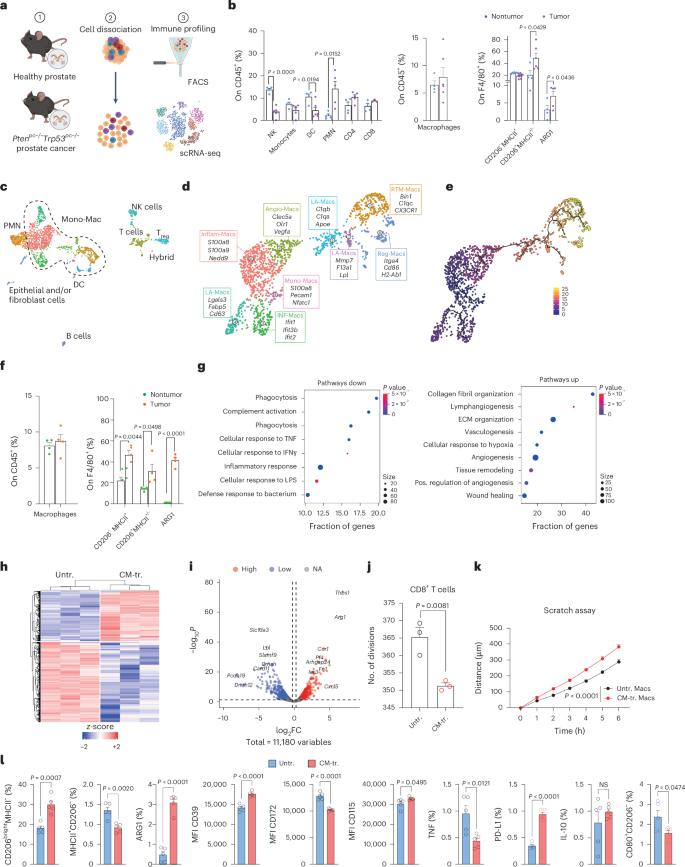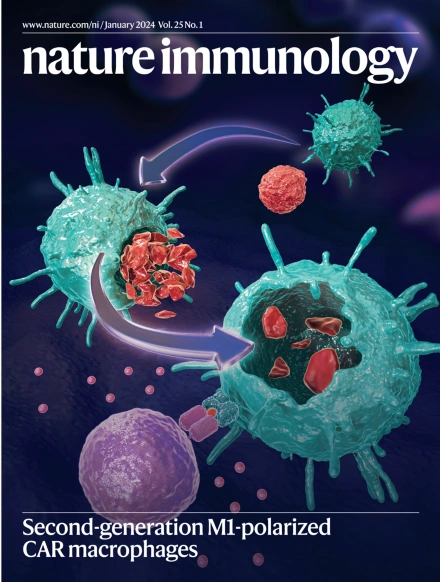化学传感器受体是肿瘤中巨噬细胞功能的脂质检测调节因子
IF 27.6
1区 医学
Q1 IMMUNOLOGY
引用次数: 0
摘要
巨噬细胞浸润肿瘤是癌症进展的标志,重新培养肿瘤相关巨噬细胞(tam)达到抗肿瘤状态是一种很有前途的免疫治疗策略。然而,癌细胞影响巨噬细胞教育的机制尚不清楚,限制了这种方法的治疗潜力。在这里,我们对原代巨噬细胞进行了无偏倚的全基因组CRISPR筛选。我们的研究证实了已知调节因子在TAM反应中的功能,并揭示了这些细胞行为的新见解。我们发现嗅觉和犁鼻受体或化学传感器是多种癌症中肿瘤支持巨噬细胞表型的重要驱动因素。在体内,tam中某些化学传感器的缺失导致癌症消退和肿瘤反应性CD8+ T细胞浸润增加。在人前列腺癌组织中,棕榈酸与tam表达的嗅觉受体51E2 (OR51E2)结合,增强其肿瘤表型。空间脂质组学分析进一步证实了棕榈酸在前列腺癌中与tam密切相关的存在,支持这种脂质介质在肿瘤微环境中的功能。总的来说,这些数据暗示了巨噬细胞对富含脂质的环境的感知中的化学传感器,并强调这些受体可能是增强抗肿瘤免疫的治疗靶点。本文章由计算机程序翻译,如有差异,请以英文原文为准。


Chemosensor receptors are lipid-detecting regulators of macrophage function in cancer
Infiltration of macrophages into tumors is a hallmark of cancer progression, and re-educating tumor-associated macrophages (TAMs) toward an antitumor status is a promising immunotherapy strategy. However, the mechanisms through which cancer cells affect macrophage education are unclear, limiting the therapeutic potential of this approach. Here we conducted an unbiased genome-wide CRISPR screen of primary macrophages. Our study confirms the function of known regulators in TAM responses and reveals new insights into the behavior of these cells. We identify olfactory and vomeronasal receptors, or chemosensors, as important drivers of a tumor-supportive macrophage phenotype across multiple cancers. In vivo deletion of selected chemosensors in TAMs resulted in cancer regression and increased infiltration of tumor-reactive CD8+ T cells. In human prostate cancer tissues, palmitic acid bound to olfactory receptor 51E2 (OR51E2) expressed by TAMs, enhancing their protumor phenotype. Spatial lipidomics analysis further confirmed the presence of palmitic acid in close proximity to TAMs in prostate cancer, supporting the function of this lipid mediator in the tumor microenvironment. Overall, these data implicate chemosensors in macrophage sensing of the lipid-enriched milieu and highlight these receptors as possible therapeutic targets for enhancing antitumor immunity. Tumor-associated macrophages are pivotal in control over solid tumors. Here the authors show that these macrophages express chemosensors that detect lipid variants in the tumor microenvironment that can regulate the function of these cells.
求助全文
通过发布文献求助,成功后即可免费获取论文全文。
去求助
来源期刊

Nature Immunology
医学-免疫学
CiteScore
40.00
自引率
2.30%
发文量
248
审稿时长
4-8 weeks
期刊介绍:
Nature Immunology is a monthly journal that publishes the highest quality research in all areas of immunology. The editorial decisions are made by a team of full-time professional editors. The journal prioritizes work that provides translational and/or fundamental insight into the workings of the immune system. It covers a wide range of topics including innate immunity and inflammation, development, immune receptors, signaling and apoptosis, antigen presentation, gene regulation and recombination, cellular and systemic immunity, vaccines, immune tolerance, autoimmunity, tumor immunology, and microbial immunopathology. In addition to publishing significant original research, Nature Immunology also includes comments, News and Views, research highlights, matters arising from readers, and reviews of the literature. The journal serves as a major conduit of top-quality information for the immunology community.
 求助内容:
求助内容: 应助结果提醒方式:
应助结果提醒方式:


